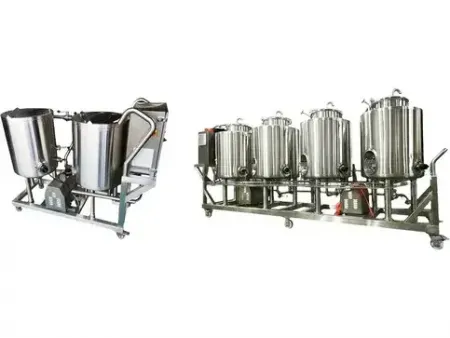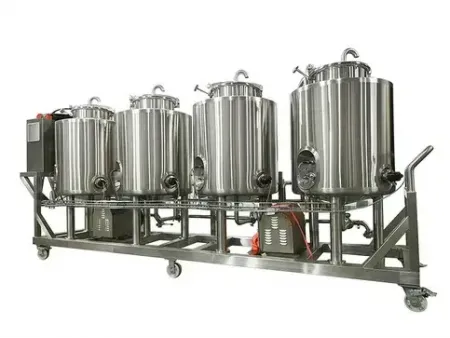Cleaning in Place (CIP) System
CIP systems are important to maintain hygiene and compliance during pharmaceutical manufacturing. Depending on the process layout, they can be installed as fixed units integrated into the production line or as mobile units that serve multiple areas. These systems clean internal surfaces, such as tanks, pipelines, and processing equipment, without the need for disassembly, reducing downtime and minimizing the risk of cross-contamination. Fully automated configurations allow real-time monitoring and control via the plant’s main control system, while manual or semi-automatic versions offer more flexibility for specific cleaning tasks. Mobile CIP systems are suitable for facilities that require shared cleaning across different production zones.
Widely used in the pharmaceutical, food, medical, and cosmetics industries, CIP systems ensure effective cleaning and disinfection of water production systems. They significantly improve cleaning efficiency, equipment availability, and product quality assurance.
- Thermal insulation thickness: ﹥ 30 mm
- Surface roughness (contact surfaces): ﹤ 0.38 μm
- Temperature control: Heating to 80°C or cooling to 20°C within 30 minutes
- CIP/SIP cycle duration: ﹤ 1 hour
Note: Each pharmaceutical water system is custom-designed to meet the user requirement specification (URS) provided by the client. All photos and videos featured are from actual WEMAC projects.
- Piping is formed from seamless stainless steel bends to minimize welding. Where welding is required, argon-shielded automatic welding is used (single-side weld with double-side formation), followed by electrochemical polishing to ensure clean and smooth inner surfaces.
- Validation documents are provided, including videos or photos from endoscopic inspections, weld maps, pressure test reports, pickling and passivation reports, and full system design documentation.
- The CIP system is equipped with a PLC HMI control setup. The interface is intuitive and supports various communication protocols. At least three user access levels can be configured to ensure operational security.
- Supervisory control and data acquisition (SCADA) integration is available for real-time data collection, monitoring, and centralized control.
- Main parameters such as conductivity, temperature, and flow rate can be monitored online, with data logging capabilities for critical process records.
- Suitable for equipment of all sizes, including large, medium, and small-scale setups. Detergents can be reused through the circulation system, maximizing efficiency.
- Compact design with a small footprint makes it easy to install and maintain. Fewer wear parts mean longer service life and lower maintenance requirements.
- Allows thorough in-place cleaning of tanks, piping, and production lines. The entire cleaning process takes place within a closed system, reducing the risk of secondary contamination.
- Cleaning operations can be automated and programmed for consistent results. The external circulation system helps reduce energy consumption.
- Available in single-tank, dual-tank, or multi-tank configurations to meet different operational needs.
- Acid tank
- Alkali tank
- Buffer tank
- Cleaning solution tank
- Double-tube sheet heat exchanger
- Cleaning pump
- Self-priming return pump
- Temperature sensors
- Return water conductivity monitor
- Return water flow meter




